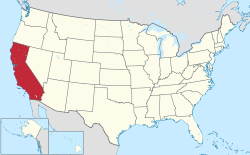This article contains unreferenced categories.(April 2024) |
| California Department of Corrections and Rehabilitation | |
|---|---|
 | |
 | |
 Badge Patch of the California Department of Corrections and Rehabilitation | |
| Common name | Department of Corrections |
| Abbreviation | CDCR |
| Agency overview | |
| Formed | 1885 |
| Preceding agency |
|
| Employees | 24,000 |
| Annual budget | US$11.3 billion (2017/2018) |
| Jurisdictional structure | |
| Operations jurisdiction | California, USA |
 | |
| Jurisdiction of the Department, excluding when transporting detainees in Nevada. [1] | |
| Size | 163,696 square miles (423,970 km2) |
| Population | 39,536,653 (2017 est.) [2] |
| Legal jurisdiction | As per operations jurisdiction |
| General nature | |
| Operational structure | |
| Headquarters | Sacramento, California |
| Parent agency | Youth and Adult Correctional Agency (1980–2004) |
| Facilities | |
| Patrol Cars |
|
| Website | |
| www | |
The California Department of Corrections and Rehabilitation (CDCR) is the penal law enforcement agency of the government of California responsible for the operation of the California state prison and parole systems. Its headquarters are in Sacramento.
Contents
- Staff size
- History
- About CDCR
- Divisions
- Offices
- Other programs
- Facilities
- Institutions
- Parole
- CDCR Peace Officers
- Correctional Peace Officer Academy
- Rank structure
- Specialized Units
- Fugitive Apprehension Team
- Special Service Unit
- Issues
- California Correctional Health Care Services (CCHCS)
- Program Shutdowns
- Division of Juvenile Justice (DJJ)
- Union: California Correctional Peace Officers Association
- See also
- References
- External links







